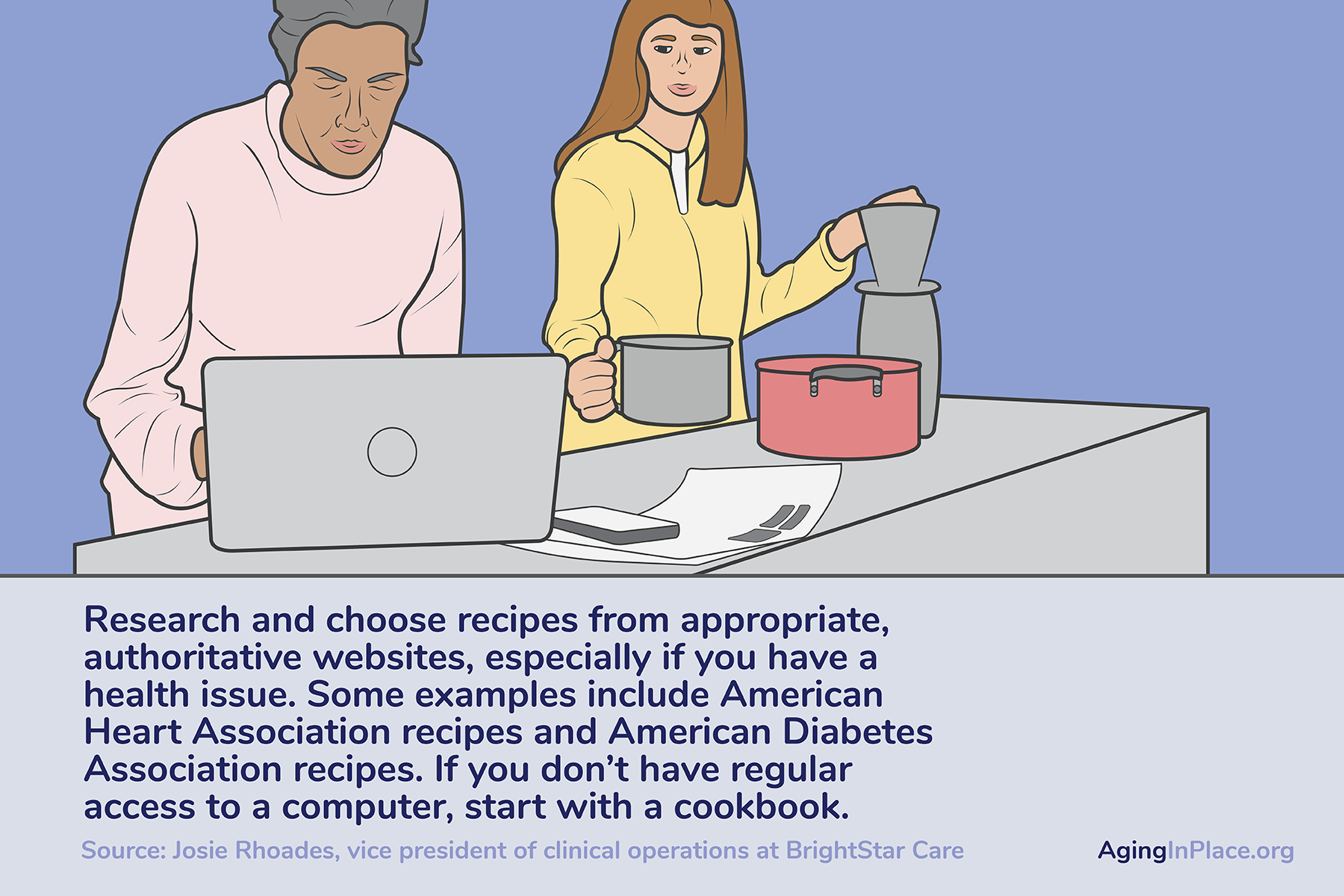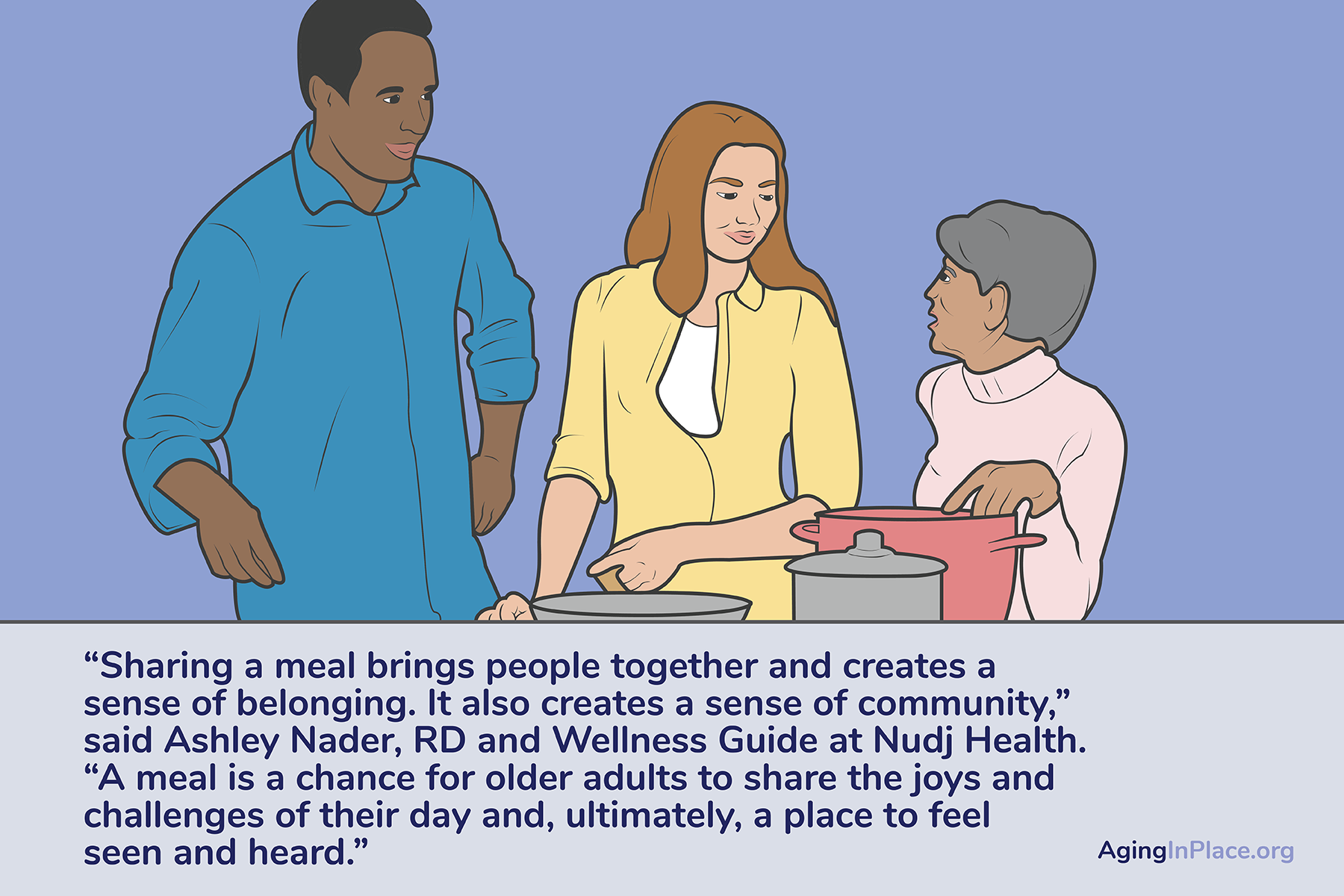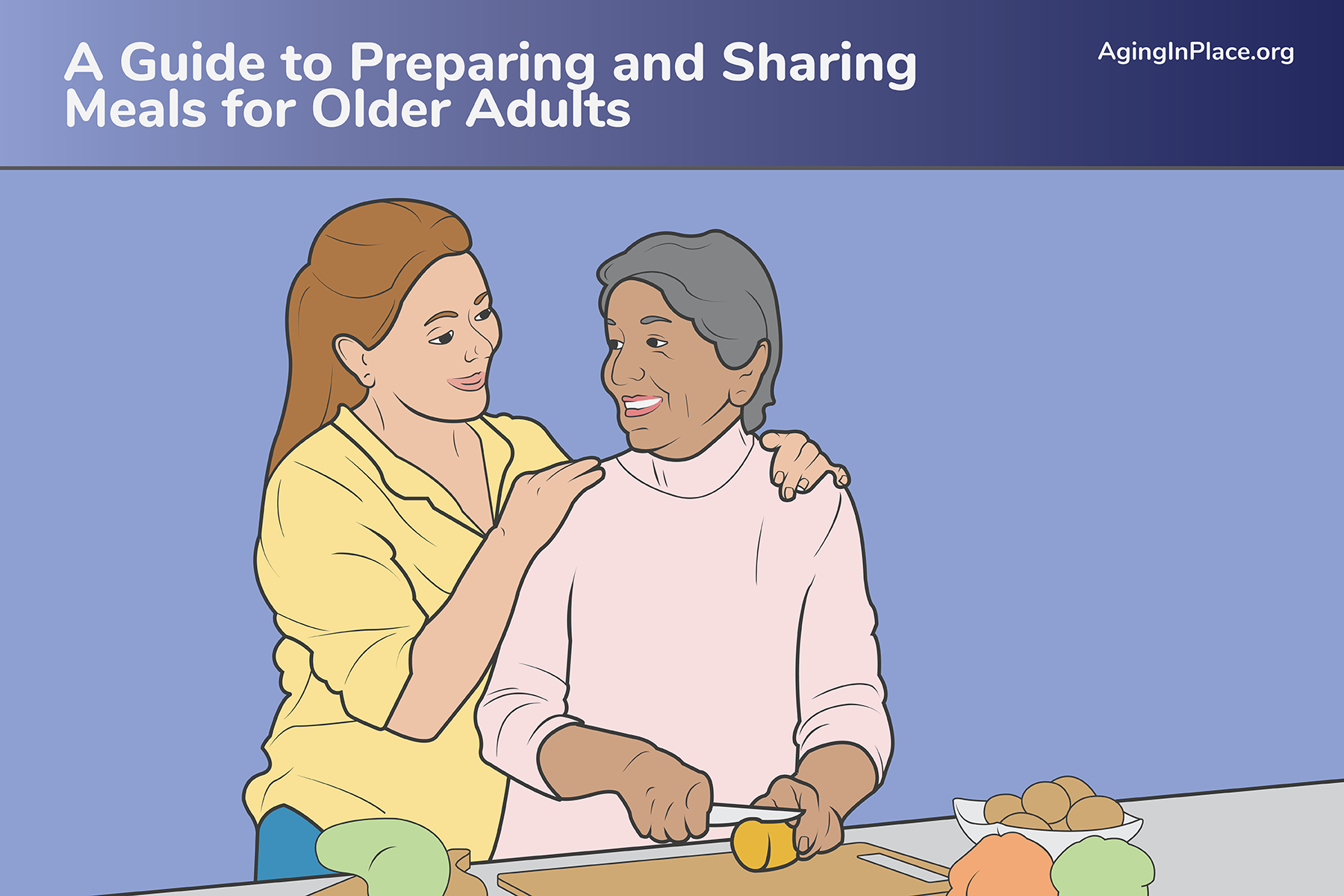How Do Our Nutritional Needs Change as We Age?

You’ve likely heard that good nutrition is crucial for healthy aging. A healthy diet can help prevent chronic diseases and health conditions such as high blood pressure, heart disease, Type 2 diabetes, and osteoporosis, according to MedlinePlus.
But “good nutrition” is a broad phrase. What exactly does a “good” nutritional diet look like as we age? The following are three major changes in our nutritional needs:
- You don’t need as many daily calories: Adults over age 50 don’t need to consume as many calories per day as young adults because of lower activity levels, the loss of muscle mass, and slower metabolism.
The number of calories you need per day will also depend on your activity level and sex. For example, the 2020 Dietary Guidelines for Americans recommends 1,800 calories per day for moderately active women 61 years and older but recommends 200 calories less per day for women who lead a more sedentary lifestyle (no additional exercise outside of typical daily activity). These guidelines recommend 2,400 calories for moderately active men 61 years and older and 400 calories less per day for sedentary men.
*Keep in mind that these are estimated recommendations. Your caloric needs may vary due to health conditions or other lifestyle factors. Speak with your healthcare provider to determine how many calories you should aim for each day.
- Your hunger triggers are not as strong: Changes to our digestive system, hormone levels, and energy levels, plus a decreased sense of smell, taste, and vision (especially if taking certain medications) are common as we get older. These physical changes can impair our appetite, according to an article in the journal Nursing Older People. You may be under-nourishing your body but not realizing it.
- You need more nutrient-dense foods and supplements: As we age, our bodies absorb fewer nutrients due to changes in our metabolism and digestive system. Certain medications may also block nutrient absorption.
Older adults need to follow a diet that is high in protein, fiber, vitamin B12, calcium, and vitamin D to help support healthy body functions like digestion, and to maintain bone and muscle mass.
To make a healthy diet part of your daily routine, follow nutritional guidance from trusted resources, like the U.S. Department of Agriculture. Become familiar with common foods with high levels of the recommended nutrients you need: This resource from the Academy of Nutrition and Dietetics is a great place to start.
Do Home-Cooked Meals Support a Healthier Lifestyle?
Preparing and cooking meals at home is an excellent way to make sure you’re eating healthier, whole foods (food in its natural state). The good news is that a warm, homemade meal doesn’t have to be complicated in order to be healthy—it’s all about the quality of the ingredients.
Cooking allows you to choose how you want to incorporate essential vitamins and nutrients into your diet.
Health Benefits of Cooking
When eating a home-cooked meal, you’re likely to eat less sugar, fat, and carbohydrates compared to a premade meal, according to a 2014 study published in Public Health Nutrition. The same study also found that people who eat a home-cooked meal for a majority of the week consumed less calories than when eating out, even when weight-loss wasn’t an intentional goal. Despite the 2014 study publication date, this is still relevant information today.
“Restaurant food and packaged foods often come with way too much unnecessary sodium, fat, and sugar,” said Kelsey Lorencz, RDN and nutrition advisor for Fin vs Fin. “While these foods are OK on occasion, making a homemade version allows you to control the amount of salt you add, what kind of fat you cook your food in, and how much sugar you use.”
Frozen dinners and fast food may be easy or inexpensive to prepare, but these highly processed foods typically contain greater levels of salt, sugar, unhealthy fats, and preservatives. Processed food and poor nutrition can increase your risk of diabetes, heart disease, obesity, cancer, and other chronic diseases, according to the National Center for Chronic Disease Prevention and Health Promotion (NCCDPHP).
Learn more about the relationship between processed food and your health with this resource from Harvard T.H. Chan School of Public Health.
In contrast to processed foods, whole foods are in (or very close to) their natural state. Whole foods are more nutritious than processed foods since vitamins and minerals are often removed and unhealthy components added during processing. For example, potato chips have less vitamin C and iron but more calories, fat, and sodium than a baked potato.
The NCCDPHP recommends incorporating generous servings of fruits, vegetables, and whole grains into your diet can strengthen your immune health and reduce the risk of cancer, Type 2 diabetes, and heart disease.
Emotional Benefits of Cooking
Picture your favorite home-cooked dish. Was this meal prepared by someone special in your family? Did you eat it every year for your birthday? This dish likely conjures up vivid, happy memories.
We have a powerful psychological connection with food. Certain dishes can stir up memories and emotions due to how the brain processes our sense of smell and taste, as noted in The Harvard Gazette.
Preparing food at home can also have powerful emotional and cognitive benefits, as highlighted in a 2022 study published in Frontiers in Nutrition. Cooking your own meals can help you feel empowered and enhance your self-esteem because you’re creating something for yourself or your loved ones.
Cooking can also be a creative, stimulating outlet.
“Cooking and baking are great for older adults because they stimulate all of the senses, allowing them to experience textures and sensations,” said Kuljit Kapur, doctor of osteopathic medicine and chief medical officer at Transitions Care. “It also gets them moving and can improve hand-eye coordination through stirring, kneading dough, and other movements.”
Getting in the kitchen is excellent for overall brain health. Learning or refining a new skill—like cooking—helps improve brain function and may slow cognitive decline, according to an article published by Harvard Health Publishing.
Simple Steps To Help Prepare Home Cooked Meals
Preparing a nutritious meal in the comfort of your own home may not be as simple as it once was.
Perhaps you’re navigating new adaptations in your kitchen—whether it’s adaptive equipment and smart appliances helping you prepare a meal, or a loved one giving you a helping hand. Or maybe you weren’t the main cook in your household and now need to learn cooking basics.
Wherever you’re at in your journey, Josie Rhoades, vice president of clinical operations at BrightStar Care, offered the following practical steps to making nutritional meals at home:


We also asked Lorencz to elaborate on her favorite cooking tips. She emphasized keeping things simple and gave an example of cooking versatile, staple ingredients like rice and chicken at the beginning of the week, then incorporating them in multiple meals throughout the week. Kelsey also suggested freezing extra servings of soup to save for a healthy sick-day meal.
Simple Modifications To Make Your Kitchen More Accessible
The following modifications are simple, budget-friendly changes you can make to your kitchen environment to help make cooking easier and more accessible.
If you use a walker or wheelchair, more major home modifications may be necessary, such as widening doorways and replacing large appliances like the refrigerator or oven for better navigation.
Swap Out Heavy Dinnerware and Pots
Heavy plates, pots, and pans are difficult to carry, and doing so can be a strain on our bodies as we get older. If you have arthritis or other dexterity issues, it may be more difficult or even impossible to transfer large pots to the stove. To help remedy this, swap out any large, heavy pots and pans for smaller ones.
It would also be helpful to replace your breakable, heavy ceramic plates with shatterproof, lighter plastic dishes. Not only is it difficult to carry a full ceramic plate, but if it’s dropped on the floor, it may be difficult to bend down and clean up the shattered pieces.
Adjust Storage Areas
Have a loved one or caregiver help you reorganize your kitchen so your storage areas fall between your waist and shoulder. Items and appliances shouldn’t be so high that you have to reach up to retrieve them, as this could lead you to lose your balance and possibly fall.
Make it easier to access your supplies by adding extra storage equipment to your cabinets. You can place a lazy Susan in your cabinet so you can rotate items from the back toward the front so you don’t have to reach for them. Purchase wire storage racks that line up plates and baking sheets vertically as opposed to stacking them on top of each other. You can also add pull-out storage shelves to your deeper cabinets for easier access.

Update Your Lighting
You don’t need to install new light fixtures or completely rewire your kitchen to add safe lighting. Replace old, dim light bulbs with LED bulbs. Add battery-powered lighting strips above the sink, under cabinets, and other common work areas.
Most lighting strips can be purchased at your local hardware store or ordered online. Many battery-powered lights include adhesive tape so you can easily place them in any area that could use extra lighting.
Remove Clutter and Add Traction
Everyone loves to add special touches to make a space their own, and the kitchen is no exception. But in a safe kitchen, practicality should win out. Keep countertop decor to a minimum. If you have decor you can’t imagine your kitchen without, get creative with showcasing it on the wall instead of on your countertop or table.
Remove clutter like mail, magazines, and house keys from valuable countertop space by assigning a basket or wall organizer for each. Throw out any decorative rugs or mats and replace them with anti-slip floor stickers to add traction and help prevent falls.
Add a Small Working Table
You may not have the stamina to stand throughout the entire preparation and cooking process. Give your feet a rest by adding a small work table (about 30 inches high) and chair where you can sit comfortably to peel and chop vegetables, season produce, stir, and perform other meal preparation tasks.
Try Smart Appliances
Create a safer and smarter kitchen with appliances that automatically shut off after they have been on for a certain amount of time. Small appliances–like a water kettle, slow cooker, pressure cooker, and toaster oven–are often available with an automatic shut off feature.
Shut-off stovetops and ovens are a heftier investment, but you may consider replacing your larger appliances with automatic shut-off models if you think this is a safety concern or if you’ve left a large appliance on recently.
Automate where you can. Replace your standard hand and dish soap dispensers with motion-sensor dispensers, use a no-touch trash can, and look for tools like an electric can opener that make small kitchen tasks easier.
Consider a medical alert system to get help quickly if you have an accident in or outside your kitchen. This safety device keeps you connected to a 24/7 emergency monitoring center with the push of a button. A monitoring center agent will dispatch emergency services and/or loved ones to your home, depending on the severity of the situation.
Some of the best medical alert systems monitor your home temperature. The device will automatically contact emergency services if its sensors detect dangerous indoor temperatures, such as an overheated stove or kitchen fire.
Other Cooking Obstacles and Tips To Address Them
Mobility Challenges
“Cooking a meal on your own can be empowering for anyone, especially for those who love cooking, but may find it a bit of a challenge as mobility difficulties set in,” said Heidi Huynh, occupational therapist, owner of Ascend Therapy Services.
Huynh offered these specific tips to help overcome mobility barriers when cooking in the kitchen:

Lack of Transportation
You may not be able to drive yourself to the grocery store, or you may have limited access to transportation. If this is the case, see if the grocery delivery services deliver to your area. It’s also worth check if your favorite grocery store offers delivery services to your home.
Meal delivery kits are another way to bring healthy, whole foods straight to your doorstep. You’ll have the freedom to choose your recipes for the week. The ingredients and recipe instructions will be packaged and delivered to your home, ready to make.
Meal delivery kits are also excellent tools to help follow a heart-healthy, low sugar, or other specific health-related diet.
“Many meal kits have diet-specific choices,” said Cara Everett, MS, RDN. “This can help give someone the guidance they need without doing too much of the work.”
Isolation
Losing a partner affects all parts of life, including mealtime. Your partner may have been the primary cook, or now it’s simply difficult to set the table for only one setting. Bring back a sense of community to your meal time by joining a local group or organization that regularly hosts meals.
You can also schedule an at-home dinner with your loved ones at least twice a week. If possible, take turns hosting and cooking for each other, or you can opt for potluck style so everyone only has to prepare one or two dishes.
If you’re new to cooking, prepare these weekly meals with a loved one to help you become more comfortable in the kitchen.
Don’t let distance get in the way of sharing a meal—if family or friends live far away and an in-person meal isn’t possible, schedule weekly video calls where you share a meal together.
Sharing a Meal Can Lead to Healthier, Happier Eating Habits
Sitting down and enjoying a meal with others is just as beneficial as cooking it.

“Sharing a meal brings people together and creates a sense of belonging. It also creates a sense of community,” said Ashley Nader, RD, at Wellness Guide at Nudj Health. “A meal is a chance for older adults to share the joys and challenges of their day and, ultimately, a place to feel seen and heard.”
Nader also added that there are physical benefits to sharing a meal. We tend to eat more high-quality fruits and vegetables when eating with others.
Most isolated older adults tend to have unhealthier eating habits, such as malnutrition or binge eating. For example, Nader explained that the stress of isolation can trigger binge eating. This is a common pattern she sees in her nutrition practice, unfortunately.
Why does eating a meal with others make such a big difference in our health and nutrition? When we eat with others, we subconsciously mirror their eating patterns and naturally make healthier food choices. We’re also creating a positive association with our dining partners and food.
“Eating with one another can enhance pleasure, specifically, pleasure that’s felt from the experience. We’re connecting food with emotional support,” Nader said.
Find local community meal opportunities and programs with the National Council on Aging (NCOA) search tool, which lists NCOA partners and older adult organizations in your area. Meals on Wheels is also a national organization with community meals and companionship services.
You can narrow your research to organizations in your area by typing “community meals for seniors near me” in your search engine. Reach out to a loved one or your local library if you need help finding the right resources.
Nourishing yourself with a warm, home-cooked meal should be an enjoyable experience. These changes don’t have to happen all at once—take one step at a time. Assess your kitchen space and decide what modifications work best for you. Make an appointment with your healthcare provider to create a wellness plan for your nutritional needs. Cook one to two homemade meals a week, find recipes you love, and expand from there.

